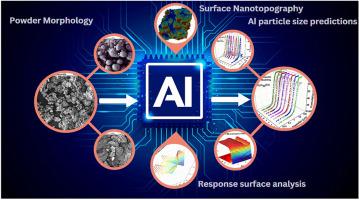基于ai增强的支持向量机框架的纳米颗粒尺寸和表面纳米形貌分析
IF 4.3
2区 材料科学
Q2 ENGINEERING, CHEMICAL
引用次数: 0
摘要
本研究提出了一种基于机器学习的方法,利用支持向量机(SVM)对高能球磨合成的Al-B4C纳米复合粉末的粒径分布(PSD)进行建模,并预测其表面特征。采用多项式(Polynomial)和径向基函数(Radial Basis Function, RBF)两个SVM核函数模拟PSD曲线和表面形貌,并通过激光粒度分析和扫描电镜(SEM)进行实验验证。模型显示出较强的预测能力,R2值在0.91 ~ 0.99之间,交叉验证系数(q2)在0.93 ~ 0.99之间。正态分布模型的RMSE值(0.11-2.13)低于累积分布模型(4.34-6.55),表明建模精度更高。扫描电镜分析显示,在铣削过程中,颗粒在4小时后从球形演变成碎片状。包括粗糙度、波浪度和各向同性在内的表面指标被量化,结果表明,由于定向变形,各向同性从0小时的82.48%下降到4小时的57.69%。高斯过程回归(Gaussian Process Regression, GPR)与实验表面趋势吻合较好,能准确预测纳米尺度的形貌参数。采用响应面法(RSM)观察了初始粒径为90nm、700nm和1200nm的B4C颗粒的粒径缩减行为。对于700 nm的颗粒,在10 h后,尺寸减小趋于稳定,而90 nm的颗粒在前5-10 h内表现出快速的细化。相比之下,1200 nm的颗粒则表现出较慢的,连续的缩小,需要15小时的研磨。支持向量机模型成功地捕获了这些非线性趋势,在中间时间点有轻微的低估。对于21 μm和71 μm的铝,RSM图显示Al-21的分布稳定均匀,而Al-71在特定条件下表现出非线性,体积百分比下降。这些发现证实了SVM和GPR是模拟球磨纳米颗粒PSD和表面演化的强大工具。本文章由计算机程序翻译,如有差异,请以英文原文为准。

AI-enhanced support vector machine framework for nanoparticle size and surface nanotopography analysis
This study presents a machine learning-based approach using Support Vector Machines (SVM) to model the particle size distribution (PSD) and predict surface characteristics of Al-B4C nanocomposite powders synthesized through high-energy ball milling. Two SVM kernels, Polynomial and Radial Basis Function (RBF), were applied to simulate PSD curves and surface morphology, with experimental validation conducted via laser particle size analysis and scanning electron microscopy (SEM). The models demonstrated strong predictive capabilities, achieving R2 values between 0.91 and 0.99 and cross-validation coefficients (q2) from 0.93 to 0.99. Normal distribution models yielded lower RMSE values (0.11–2.13) compared to cumulative distribution models (4.34–6.55), indicating higher precision in modeling. SEM analysis revealed morphological transitions during milling, with particles evolving from spherical to fragmented shapes after 4 h. Surface metrics including roughness, waviness, and isotropy were quantified, showing that isotropy decreased from 82.48 % at 0 h to 57.69 % at 4 h due to directional deformation, then partially recovered to 62.50 % at 10 h. Gaussian Process Regression (GPR) showed strong alignment with experimental surface trends and accurately predicted nanoscale topographic parameters. Response Surface Methodology (RSM) was employed to visualize size reduction behavior for B4C particles with initial sizes of 90, 700, and 1200 nm. For 700 nm particles, size reduction stabilized beyond 10 h, while 90 nm particles exhibited rapid refinement within the first 5–10 h. In contrast, 1200 nm particles showed slower, continuous reduction requiring >15 h of milling. SVM models successfully captured these nonlinear trends, with minor underestimations at intermediate time points. RSM plots for aluminum particle sizes (21 and 71 μm) revealed that Al-21 led to stable and uniform distributions, whereas Al-71 exhibited nonlinear behavior with volume percentage drops under specific conditions. These findings confirm that SVM and GPR are robust tools for modeling PSD and surface evolution in ball-milled nanoparticles.
求助全文
通过发布文献求助,成功后即可免费获取论文全文。
去求助
来源期刊

Particuology
工程技术-材料科学:综合
CiteScore
6.70
自引率
2.90%
发文量
1730
审稿时长
32 days
期刊介绍:
The word ‘particuology’ was coined to parallel the discipline for the science and technology of particles.
Particuology is an interdisciplinary journal that publishes frontier research articles and critical reviews on the discovery, formulation and engineering of particulate materials, processes and systems. It especially welcomes contributions utilising advanced theoretical, modelling and measurement methods to enable the discovery and creation of new particulate materials, and the manufacturing of functional particulate-based products, such as sensors.
Papers are handled by Thematic Editors who oversee contributions from specific subject fields. These fields are classified into: Particle Synthesis and Modification; Particle Characterization and Measurement; Granular Systems and Bulk Solids Technology; Fluidization and Particle-Fluid Systems; Aerosols; and Applications of Particle Technology.
Key topics concerning the creation and processing of particulates include:
-Modelling and simulation of particle formation, collective behaviour of particles and systems for particle production over a broad spectrum of length scales
-Mining of experimental data for particle synthesis and surface properties to facilitate the creation of new materials and processes
-Particle design and preparation including controlled response and sensing functionalities in formation, delivery systems and biological systems, etc.
-Experimental and computational methods for visualization and analysis of particulate system.
These topics are broadly relevant to the production of materials, pharmaceuticals and food, and to the conversion of energy resources to fuels and protection of the environment.
 求助内容:
求助内容: 应助结果提醒方式:
应助结果提醒方式:


